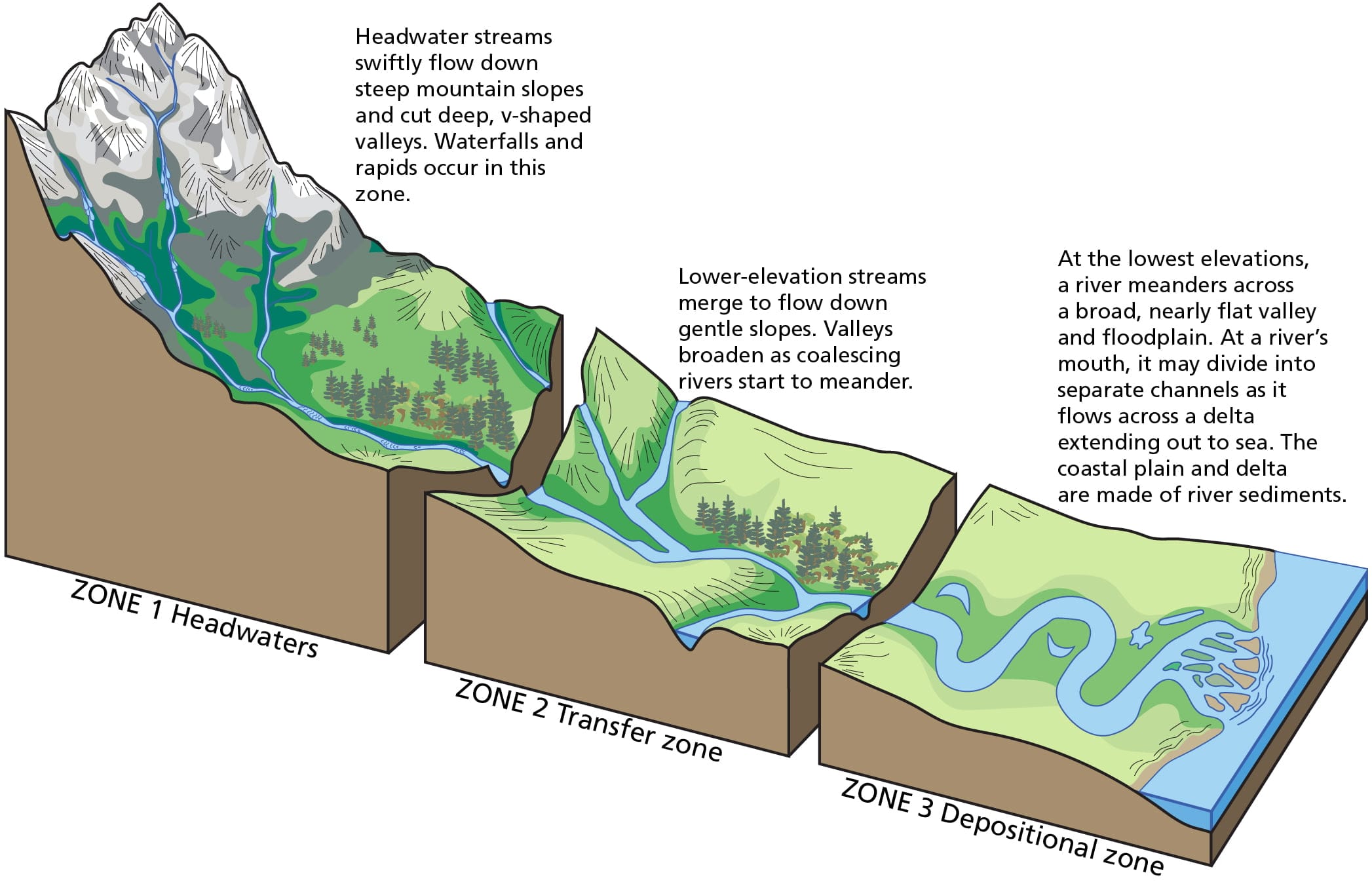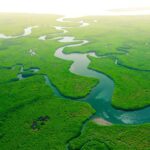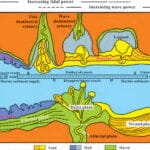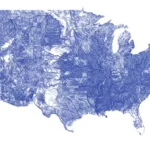Get ready to dive into the enchanting realm of estuaries, where rivers and oceans converge in a captivating dance. This article delves into the fascinating world of these unique ecosystems, exploring their characteristics, ecological significance, and the challenges they face. From the river’s edge to the open sea, we’ll unravel the secrets of these coastal treasures where life flourishes, and nature paints a breathtaking panorama.
What is the mouth of the river called?
Picture a river, its course meandering like a silver ribbon across the landscape. It originates as a mere trickle high in the mountains, gaining momentum and volume as it traverses valleys and plains. But where does this journey culminate? Where does the river finally meet its larger, more imposing sibling – the sea, the ocean, or perhaps a vast lake?
This point of confluence, where the river’s freshwater embraces the ocean’s salty expanse, is known as the mouth of the river. It’s a zone of captivating transition, a mixing bowl where two distinct worlds collide, giving rise to an entirely new and fascinating environment.
This unique environment is called an estuary, and it transcends the simplistic notion of a mere meeting point. It teems with life, a vibrant hub where freshwater species coexist and interact with their saltwater counterparts, all drawn to the rich tapestry of nutrients delivered by the river.
What Makes River Mouths So Special?
Several factors contribute to the remarkable nature of river mouths.
- Mixing Zones: Estuaries function as colossal mixing bowls, blending freshwater laden with sediment and nutrients from the river’s journey with the saline water of the ocean. This creates a gradient – a gradual transition from freshwater to saltwater – supporting an astounding diversity of life. Not all aquatic organisms thrive in the extremes of pure freshwater or the open ocean’s salinity. Estuaries, however, provide a spectrum of salinity, catering to a wide array of species.
- Nurseries of Life: The abundance of nutrients, stemming from the river’s input and the mixing of waters, transforms estuaries into highly productive nurseries for a myriad of fish and shellfish species, many of which play a vital role in our own food supply. The sheltered environment and ample food supply provide ideal conditions for juvenile organisms to grow and mature.
- Natural Engineers: Rivers serve as nature’s conveyor belts, transporting sediment – fragments of rock, soil, and organic matter – downstream. Upon reaching the mouth, a portion of this sediment settles, giving rise to distinctive landforms such as deltas and sandbars. These features are not merely aesthetically pleasing; they act as natural buffers, safeguarding coastlines from the erosive forces of waves and storm surges.
- Ecological Guardians: Estuaries play a crucial role in maintaining the health of coastal ecosystems. They act as giant filters, purifying water by removing pollutants before they reach the open ocean. Additionally, they are essential for nutrient cycling, ensuring a healthy equilibrium within the coastal environment.
River Mouths: Sentinels of a Changing World
Despite their importance, river mouths face mounting pressure from human activities, compounded by the impacts of climate change. Pollution from upstream sources, habitat destruction driven by development, and the encroaching threat of rising sea levels all jeopardize the delicate balance of these ecosystems. Understanding the intricate workings of river mouths and the challenges they confront is paramount to safeguarding these vital environments for future generations.
Scientists are continuously engaged in studying these dynamic interfaces, striving to unravel the complexities of their function and the ways in which they are impacted by change. While much remains to be discovered, one thing is certain: the well-being of our rivers, our coasts, and indeed the entire planet is inextricably linked to the fate of these remarkable meeting places where rivers converge with the sea.
What is the word river mouth?
Every river embarks on a journey, a course that ultimately leads to a larger body of water. This terminus, where the river relinquishes its freshwater to a lake, ocean, or another, more expansive river, is what we call the river mouth.
However, the river mouth is not merely a point of convergence. It’s a dynamic and ecologically significant zone. As the river’s flow meets the receiving water body, it creates a unique environment known as an estuary. This blending of freshwater and saltwater results in brackish conditions, fostering a rich tapestry of life. Estuaries are biodiversity hotspots, attracting a diverse array of plants and animals adapted to this fluctuating environment.
One fascinating aspect of river mouths is their inherent dynamism. They are not static features but rather evolve over time. Natural forces, such as erosion caused by the river’s flow or the deposition of sediment, can gradually alter the shape and location of a river mouth. Human activities, too, can influence these changes through dredging, damming, or altering the river’s course.
What is the wide mouth of a river called?
When a river concludes its journey by meeting the ocean, it often does so in a grand and dramatic fashion, forming a wide expanse known as an estuary. This meeting point is far from ordinary. It’s a dynamic interplay of freshwater from the river and the salty embrace of the sea, creating a unique and productive ecosystem.
The hallmark of an estuary is its brackish water, a blend of freshwater and saltwater. This mix, along with the abundance of nutrients carried by the river, creates incredibly fertile grounds, supporting a remarkable diversity of life. Estuaries are teeming with fascinating creatures, from tiny invertebrates to large fish and wading birds, all adapted to thrive in these fluctuating conditions.
As the river’s flow enters the estuary, it gradually slows, leading to the deposition of sediment carried downstream. This sediment, over time, can give rise to remarkable landforms. Deltas, those iconic fan-shaped areas extending into the sea, are prime examples of how sediment deposition shapes estuarine landscapes. In addition to deltas, estuaries may feature sandbars, mudflats, and salt marshes, each contributing to the ecological richness of these environments.
Estuaries are not merely scenic; they provide invaluable ecological services. They serve as vital nurseries for numerous fish and shellfish species, offering sheltered waters where young organisms can mature before venturing into the open ocean. Furthermore, estuaries act as natural filters, removing pollutants and excess nutrients from the water, protecting the health of coastal waters.
Despite their ecological importance, estuaries face increasing threats from human activities and climate change. Pollution from upstream sources, habitat destruction, and the encroaching threat of rising sea levels all pose significant challenges to the delicate balance of these ecosystems.
What is the Mouth and Head of a River?
Imagine a river’s course as an epic journey, a flowing narrative across the landscape. Every river has a beginning and an end, a source and a destination. These points, respectively, are known as the “head” and the “mouth” of the river.
The mouth of a river, often culminating in a dramatic flourish, marks the point where the river completes its journey and merges with a larger body of water. This could be a grand confluence with the ocean, a gentle flow into a serene lake, or even the merging of forces with another, more massive river.
Conversely, the head of a river represents its birthplace, often nestled high in the mountains or hills. It’s here that the river’s story begins, typically from the accumulation of rainwater, snowmelt, or the emergence of groundwater springs. These nascent trickles, gathering strength as they converge, carve their way downhill, gradually forming a defined channel.
The River’s Epic Journey: From Trickle to Torrent
The river’s journey from head to mouth is rarely a straight and predictable path. It’s a tale of twists and turns, of carving through rock and meandering across plains. Along this journey, the river acts as a sculptor, shaping the landscape it traverses. The force of the water erodes riverbanks, transporting sediment downstream. This sediment, deposited at the river’s mouth, contributes to the formation of features like deltas and sandbars.
The Mouth: Where Rivers Meet the World
River mouths are vibrant hubs of life. The mixing of freshwater and saltwater creates a unique environment, attracting a diverse array of plants and animals adapted to these brackish conditions. Many fish species rely on estuaries, the zones where rivers meet the sea, as nurseries for their young or as bountiful feeding grounds. The sediment deposited by the river also plays a vital role, acting as a natural barrier that protects the coastline from erosion caused by waves and storms.
The Headwaters: A Crystal-Clear Cradle of Life
In contrast to the bustling activity of a river’s mouth, headwaters present a scene of tranquility. The water here is often pristine, its clarity a testament to its origin from snowmelt or springs. The cool, oxygen-rich water of headwaters provides ideal conditions for fish species like trout and salmon. Beyond their importance for aquatic life, headwaters are vital for the health of entire ecosystems. They contribute to water quality downstream and serve as essential sources of water for humans and wildlife alike.
Wrapping Up the River’s Tale
The mouth and head of a river, far from being mere geographical points, are integral components of a dynamic and interconnected system. Understanding these concepts sheds light on the vital role rivers play in shaping our landscapes, supporting biodiversity, and providing us with essential resources. While our understanding of rivers continues to grow, there’s always more to discover. Scientists are constantly making new findings about the intricate workings of these awe-inspiring waterways. So, the next time you encounter a river, take a moment to appreciate its remarkable journey – from its humble beginnings to its dramatic finale at the edge of the sea.
What is a synonym for the mouth of a river?
While “mouth” aptly describes the point where a river concludes its journey, there are several other terms used to denote this watery confluence.
- Estuary: This term encapsulates not just the river’s mouth but also the surrounding area where freshwater and saltwater intermingle, creating a unique and biodiverse ecosystem.
- Distributary: When a river, approaching its terminus, branches into multiple channels, each flowing into a different part of the coastline, these individual channels are known as distributaries. This branching pattern is often observed in river deltas.
- Outlet: A more general term, “outlet” simply refers to the point where any waterway, be it a river, stream, or even a drainage canal, discharges its water into a larger body of water.
- Outfall: This term typically describes a specific point of discharge, often associated with human-made structures. For instance, a sewage treatment plant or a stormwater drainage system might have an outfall where treated water is released back into a river, lake, or ocean.
So, the next time you find yourself discussing rivers and their watery destinations, you can impress your audience with your knowledge of estuarine dynamics and distributary networks! Remember, rivers are full of surprises, their journeys as captivating as their final destinations.
Important Points about River Mouths and Estuaries
Here are some key takeaways about river mouths and estuaries:
- Definition: The mouth of a river is the point where it discharges its water into a larger body of water, such as a lake, sea, or ocean. This confluence zone is often referred to as an estuary.
- Ecological Significance: Estuaries are incredibly important ecosystems. The mixing of freshwater and saltwater creates a unique environment that supports a diverse range of plant and animal life. They serve as vital nurseries for many fish and shellfish species, providing sheltered habitats for juveniles to grow.
- Landform Formation: Rivers transport sediment downstream, and when they reach their mouths, this sediment is deposited, contributing to the formation of distinctive landforms like deltas, sandbars, and mudflats.
- Natural Filters: Estuaries act as natural filters, helping to remove pollutants and excess nutrients from the water before they reach the open ocean. This filtering capacity helps maintain water quality in coastal areas.
- Threats and Challenges: Estuaries face a number of threats, many stemming from human activities. These include pollution from upstream sources, habitat destruction due to development, and the impacts of climate change, such as rising sea levels.
Understanding and protecting river mouths and estuaries is crucial for the health of our planet. They are essential for maintaining biodiversity, supporting fisheries, protecting coastlines, and ensuring the overall health of our oceans.
Have you ever wondered about the longest river in the world? What about the largest river in Asia? If you’re curious about the world’s widest river, click here. And if you want to know about the longest rivers in Africa, we’ve got you covered. Finally, don’t miss out on our article about the widest river in the world. We also have a fascinating article on the two largest rivers in the US.
- Sept 31 Myth: Unveiling Calendar Secrets - March 18, 2025
- How Long & Till December 18, 2025: Accurate Countdown Guide - March 18, 2025
- Discover Japanese Artists: A Complete History - March 18, 2025

















1 thought on “Unveiling the Estuary: Where River Meets Sea”
Comments are closed.